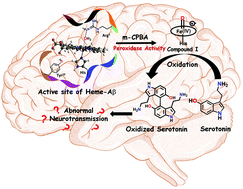Peroxidase activity of heme bound amyloid β peptides associated with Alzheimer's disease
Abstract
The amyloid cascade hypothesis attributes the neurodegeneration observed in Alzheimer's disease (AD) to the deposition of the amyloid β (Aβ) peptide into plaques and fibrils in the AD brain. The metal ion hypothesis which implicates several metal ions, viz. Zn2+, Cu2+ and Fe3+, in the AD pathology on account of their abnormal accumulation in the Aβ plaques along with an overall dyshomeostasis of these metals in the AD brain was proposed a while back. Metal ion chelators and ionophores, put forward as possible drug candidates for AD, are yet to succeed in clinical trials. Heme, which is widely distributed in the mammalian body as the prosthetic group of several important proteins and enzymes, has been thought to be associated with AD by virtue of its colocalization in the Aβ plaques along with the similarity of several heme deficiency symptoms with those of AD and most importantly, due to its ability to bind Aβ. This feature article illustrates the active site environment of heme-Aβ which resembles those of peroxidases. It also discusses the peroxidase activity of heme-Aβ, its ability to effect oxidative degradation of neurotransmitters like serotonin and also the identification of the highly reactive high-valent intermediate, compound I. The effect of second sphere residues on the formation and peroxidase activity of heme-Aβ along with the generation and decay of compound I is highlighted throughout the article. The reactivities of heme bound Aβ peptides give an alternative theory to understand the possible cause of this disease.



 Please wait while we load your content...
Please wait while we load your content...